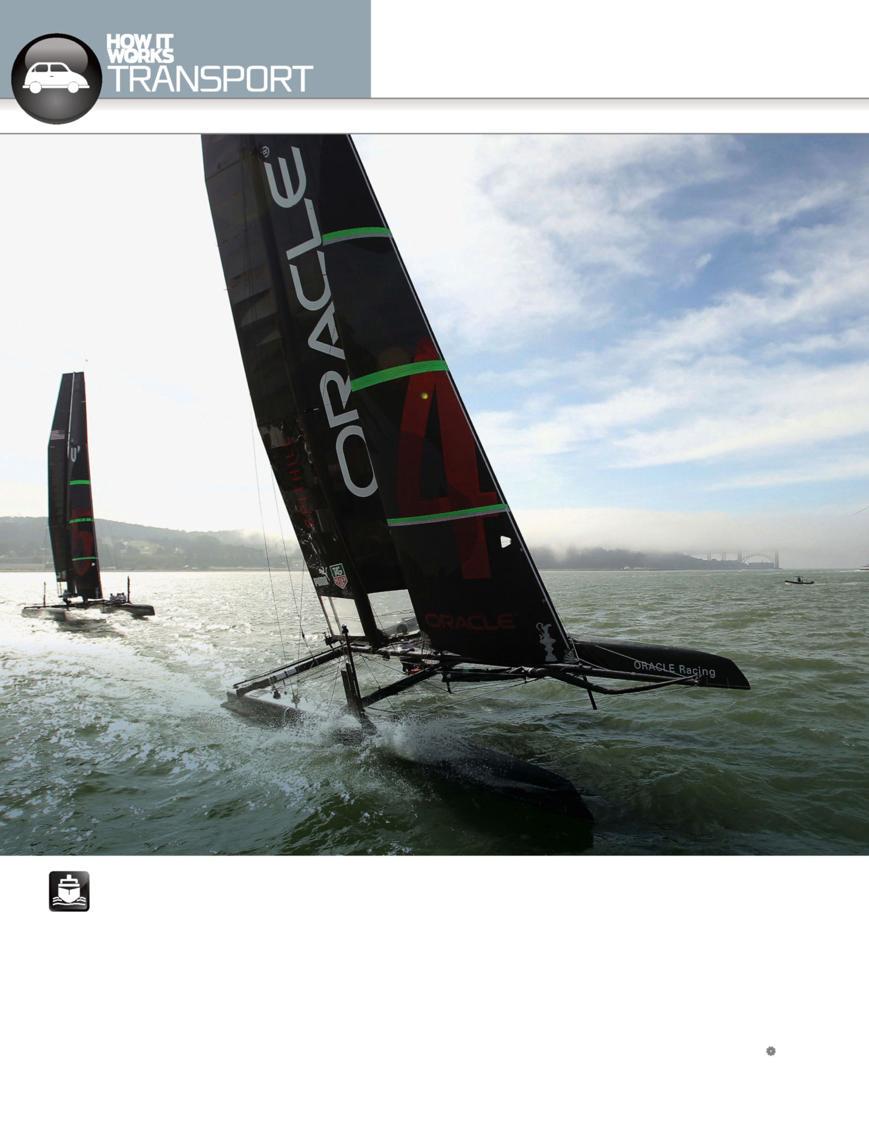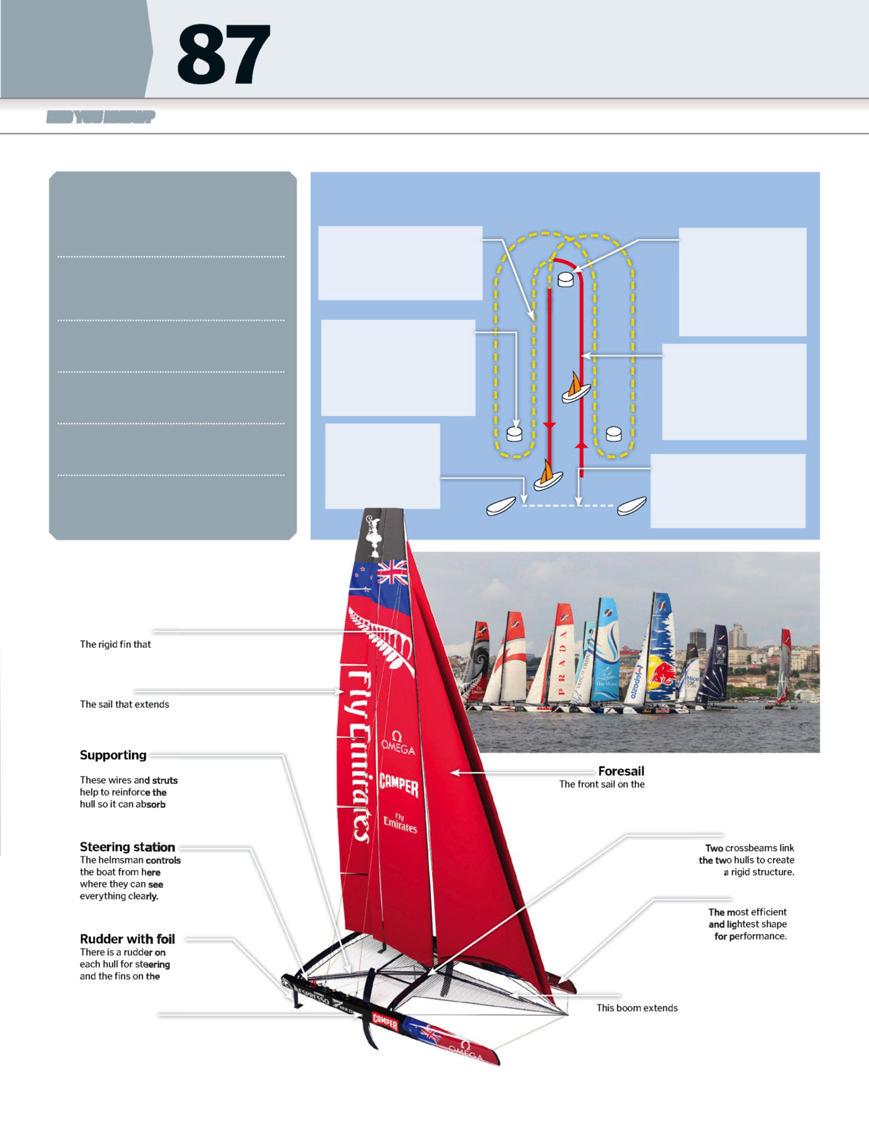
4 minute read
Racing yachts
TRANSPORT
Able to hit speeds in excess of 20 knots (37km/h; 23mph) the Oracle AC45 was used in both 2011 and 2012’s America’s Cup
Advertisement
Next-gen racing yachts
Manufactured using aircraft technology, today’s racing yachts have the ability to sail faster than the wind thanks to a unique balancing act
Modern racing yachts take the latest aircraft technology to build the lightest and fastest sailboats. Weight is critical to performance, but just like a plane, the stresses are also very high so designers have to fi nd the critical balance between the lightest weight and the maximum strength. Advanced composites combining carbon fi bre, Kevlar and epoxy resins are blended and then cooked in a vast ‘oven’ for the optimum shell.
The top racing catamarans are the ultimate sailboats for performance because their slim hulls are the most effi cient in terms of resistance. Their stability comes from the wide beam and they need no ballast keel to balance the boat against wind pressure. To reduce resistance further they have foils on fi ns below the hull that generate lift to bring the hull clear of the water so they glide across the waves.
The mast and sails also use aircraft tech to create an effi cient aerofoil shape. Sails are made from exotic fi bres such as a polyester fi lm laminated over a carbon-fi bre base for high strength and a smooth surface. On racing catamarans the sails are matched to a wing mast that is part of the required aerofoil shape which allows the yacht to sail upwind at speed.
Actually sailing these yachts is also a great balancing act. The hull on the windward side comes completely clear of the water and the helmsman has to balance the stability against the wind pressure to power the yacht forward. On the most advanced racing catamarans speeds of 40 knots (74 kilometres/46 miles per hour) are possible, making for both very exciting and very demanding racing.
DID YOU KNOW?
Some boats can sail faster than the wind as the sails accelerate the wind as it passes over their curved surfaces
Sailing lingo
Tacking
Sailing in a series of dog-legs to make progress into the wind.
Close-hauled
This means sailing as close to the wind as possible. Racing yachts can normally sail at about 40 degrees off the wind.
Spinnaker
A big balloon sail designed to catch as much wind as possible when sailing downwind.
Downwind sailing
Sailing with the wind behind when the maximum sail area is exposed to the wind.
Reaching
Sailing with the wind on the beam, which is often the fastest type of sailing.
Foils
Small aerofoil-shaped winglets attached to the rudder and a fi n that generate lift from the water fl owing past to decrease resistance.
A sailing race step-by-step
The main stages in a windward-leeward buoy course explained
4. Downwind leg
Here you fl y the spinnaker sail to catch as much wind as possible. A competitor close behind can blanket your wind and catch up.
5. Rounding the bottom mark
Here the crew need skilful sail handling to bring the spinnaker in without allowing it in the water and to set the sails ready for tacking on the upwind leg.
6. Finish
There may be several circuits before the fi nish, which is always at the end of the downwind leg.
3. Rounding the top mark
Here you aim to round the mark (a buoy) as close as possible without touching it, but competitors may impede you as the inside yacht always has priority.
2. Upwind leg
Here the yachts are tacking, sailing close to the wind and heading in a series of tacks to the top mark. You have the advantage when the wind is on your starboard (right) side.
1. Start
The start is always upwind so you need to fi nd a place on the start line at one end if possible so you cross the line fi rst.
Racing yacht anatomy

We highlight the major components of a cuttingedge sailing boat and explain the role they play
Competing in the Extreme Sailing Series requires a combination of great skill and engineering
Wing mast
The rigid fi n that supports the sails and also acts as an aerofoil.
Mainsail
The sail that extends aft from the mast to complete the aerofoil.
Supporting structure
These wires and struts help to reinforce the hull so it can absorb high stresses.
Steering station
The helmsman controls the boat from here where they can see everything clearly.
Rudder with foil
There is a rudder on each hull for steering and the fi ns on the bottom generate lift.
Fin with foil
This fi n helps to prevent the boat drifting sideways and the foil generates lift.
Foresail
The front sail on the yacht that curves into an aerofoil shape to generate thrust.
Crossbeam
Two crossbeams link the two hulls to create the two hulls to create a rigid structure. a rigid structure.
Slim hull
The most effi cient and lightest shape and lightest shape for performance. for performance.
Bowsprit
This boom extends forward from the crossbeams to support the foresail.








